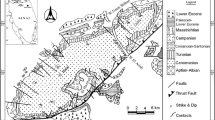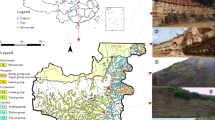Abstract
Geo-engineering properties of rocks, including discontinuity properties, physical and mechanical properties and crack propagation under axial loads, are affected by weathering. All of these rock properties have an impact on various scales on engineering applications. Therefore, weathering-related variations on rocks and rock masses are of great importance. In this study, dunites and diorites are compared from the view of weathering-related geo-engineering property variations both on field and on laboratory scales. The studies were initiated in the field by measuring the discontinuity properties, including spacing, aperture fill material, roughness and Schmidt hammer rebound tests. Mineralogical and petrographic investigations were performed on thin sections gathered from different weathering grades. The quantitative petrographic studies were concentrated on the micropetrographic index and the quantification of microcracks. At this stage of the study, a new method to quantify microcracks was proposed. Basic physical and mechanical properties (e.g., specific gravity, dry and saturated unit weights, water absorption, effective porosity, P-wave velocity, uniaxial compressive strength and slake-durability index test) were also investigated on samples of all of the weathering grades where the sample preparation was available. The data obtained from the field studies suggest that dunite discontinuity spacing decreases from 577 to 1 cm and ranges from 487 to 1 cm for diorite. Schmidt hammer rebound test values (SHV) in the field were only obtained for fresh, slightly weathered and moderately weathered grades. SHV values range from 54 to 41 for dunite and 63 to 32 for diorite. The quantitative microcrack data obtained during the petrographic studies indicated that microcracks for diorite increase with increasing weathering, but a decrease was observed for dunite, which was related to the formation of serpentine minerals with weathering. Furthermore, with increasing weathering, the changes in the physical properties of dunite specimens exhibit a wider range than in the diorite specimens. Unconfined compressive test results for the rocks showed similar decreasing trends with weathering, but the dunite specimen started to slake by the highly weathered stage, where the diorite exhibited a considerable slaking by the completely weathered stage. This research concludes that the micropetrographic index and quantitative microfracture data provide useful input to recognize the weathering grades of studied rocks. It is also emphasized that serpentinization is the distinct process for dunite weathering and has a high impact on the weathering process, influencing physical and mechanical properties considerably. However, the increase of micro- and macrocracks is the dominant distinctive feature for diorite weathering.

(geological map modified from Ündül 2007)

(modified from Ündül and Tuğrul 2012)









Similar content being viewed by others
References
ANON (1995) The description and classification of weathered rocks for engineering purposes. Q J Eng Geol 28:207–242
Arıkan F, Ulusay R, Aydın N (2007) Characterization of weathered acidic volcanic rocks and a weathering classification based on a rating system. Bull Eng Geol Environ 66:415–430
Begonha A, Braga MAS (2002) Weathering of the Oporto granite: geotechnical and physical properties. Catena 49:57–76
Ceryan Ş (2015) New weathering indices for evaluating durability and weathering characterization of crystalline rock material: a case study from NE Turkey. J Afr Earth Sci 103:54–64
Chandler RJ (1969) The effect of weathering on the shear strength properties of the Keuper Marl. Geotechnique 19:321–334
Ciantia MO, Castellanza R, Crosta GB, Huecke T (2015) Effects of mineral suspension and dissolution on strength and compressibility of soft carbonate rocks. Eng Geol 184:1–18
Dearman WR (1974) Weathering classification in the characterization of rock for engineering purposes in British practice. Bull Int Assoc Eng Geol 9:33–42
Dearman WR, Baynes EJ, Irfan TY (1978) Engineering grading of weathered granite. Eng Geol 12:345–374
Dhakal G, Yoneda T, Kata Y, Kaneko K (2002) Slake durability and mineralogical properties of some pyroclastic and sedimentary rocks. Eng Geol 65:31–45
Diamantis K, Gartzos E, Migiros G (2009) Study on uniaxial compressive strength, point load strength index, dynamic and physical properties of serpentinites from Central Greece: test results and empirical relations. Eng Geol 108:199–207
Emre H (1986) The geology and petrology of Orhaneli Ophiolite. Ph.D. thesis, Istanbul University (unpublished, in Turkish)
Franklin JA, Chandra R (1972) The slake durability test. International Journal of Rock Mechanics and Mining Sciences and Geomechanics Abstracts, vol 9, pp 325–341
Freire-Lista DM, Fort R, Varas-Muriel MJ (2015) Freeze—thaw fracturing in building granite. Cold Reg Sci Technol 113:40–51
Gamble JC (1971) Durability-plasticity classification of shales and other argillaceous rocks. Ph.D. thesis, Department of Geology, Univ. Illinois at Urbana, Champaign, Urbana
Gökçeoğlu C, Aksoy H (2000) New approaches for the characterization of clay-bearing, densely jointed and weak rock masses. Eng Geol 1:1–23
Gökçeoğlu C, Zorlu K, Ceryan S, Nefeslioglu HA (2009) A comparative study on indirect determination of degree of weathering of granites from some physical and strength parameters by two soft computing techniques. Mater Charact 60:1317–1327
Gupta AS, Rao S (2001) Weathering indices and their applicability for crystalline rocks. Bull Eng Geol Environ 60:201–221
Heidari M, Momeni AA, Naseri F (2013) New weathering classifications for granitic rocks based on geomechanical parameters. Eng Geol 166:65–73
Irfan TY, Dearmann WR (1978) The engineering petrography of a weathered granite in Cornwall, England. Q J Eng Geol 11:233–244
ISRM (2007) The complete ISRM suggested methods for rock characterization, testing and monitoring: 1974–2006. Suggested methods prepared by the commission on testing methods, International Society for Rock Mechanics, Compilation Arranged by the Turkish National Group, Ankara
Khandelwal M, Ranjith PG (2010) Correlating index properties of rocks with P-wave measurements. J Appl Geophys 71:1–5
Khanlari GR, Heidari M, Momeni AA (2012) Assessment of weathering processes effect on engineering properties of Alvand granitic rocks (west of Iran), based on weathering indices. Environ Earth Sci 67:713–725
Kiersch GA, Treacher RC (1955) Investigations, areal and engineering geology—Folsom Dam project, central California. Econ Geol 50:271–310
Kılıç R, Koçbay A, Sel T (1998) The geomechanical properties and alteration degree of serpentinite in the Ankara Ophiolitic Melange, Turkey. In: 8th international IAEG congress, proceedings, Vancouver, pp 243–251
Kılıç R, Ulamış K, Kadıoğlu YK, Yurdakul M (2010) Investigation of alteration degree of metacrystalline rocks in the vicinity of Bolu, Turkey. Mühendislik Jeolojisi Bülteni – In Turkish 30:17–34
Little AL (1969) The engineering classification of residual tropical soils. In: Proceedings of the 7th international conference on soil mechanics and foundation engineering, vol 1, pp 1–10
Mandal T, Tinjum JM, Edil TB (2016) Non-destructive testing of cementitiously stabilized materials using ultrasonic pulse velocity test. Transp Geotech 6:97–107
Marques EAG, Barroso EV, Menezes-Filho AP, Vargas EDA Jr (2010) Weathering zones on metamorphic rocks from Rio de Janeiro—physical, mineralogical and geomechanical characterization. Eng Geol 111:1–18
Martin RP (1986) Use of index tests for engineering assessment of weathered rocks. In: 5th international IAEG congress proceedings, Buenos Aires, pp 433–460
Momeni AA, Khanlari GR, Heidari M, Sepahi AA, Bazvand E (2015) New engineering geological weathering classifications for granitoid rocks. Eng Geol 185:43–51
Moye DG (1955) Engineering geology for the snowy mountains scheme. J Inst Eng Aust 27:287–289
Pola A, Crosta GB, Fusi N, Castellanza R (2014) General characterization of the mechanical behaviour of different volcanic rocks with respect to alteration. Eng Geol 169:1–13
Rigopoulos I, Tsikouras B, Pomonis P, Hatzipanagiotou K (2011) Microcracks in ultrabasic rocks under uniaxial compressive stress. Eng Geol 117:104–113
Rigopoulos I, Tsikouras B, Pomonis P, Hatzipanagiotou K (2015) Assessment of the engineering behavior of ultramafic and mafic rocks using chemical indices. Eng Geol 196:222–237
Ruxton BP, Berry L (1957) Weathering of granite and associated erosional features in Hong Kong. Bull Geol Assoc Am 68:1263–1292
Scarciglia F, Critelli S, Borrelli L, Coniglio S, Muto F, Perri F (2016) Weathering profiles in granitoid rocks of the Sila Massif uplands, Calabria, southern Italy: new insights into their formation processes and rates. Sediment Geol 336:46–67
Singh RN, Gahrooee DR (1989) Application of rock mass weakening coefficient for stability assessment of slopes in heavily jointed rock masses. Int J Surf Min Reclam Environ 3:207–219
Tuğrul A (1995) The effects of weathering on the engineering properties of basalts in the Niksar region. Ph.D. thesis, Istanbul University
Ündül Ö (2007) The effect of weathering on the engineering properties of ultramafic rocks in Cınarcık dam reservoir area (Bursa) Ph.D. thesis, Istanbul University, p 141 (unpublished, in Turkish)
Ündül Ö, Tuğrul A (2012) The influence of weathering on the engineering properties of dunites. Rock Mech Rock Eng 45:225–239
Ündül Ö, Tuğrul A, Özyalın Ş, Zarif Hİ (2015) Identifying the changes of geo-engineering properties of dunites due to weathering utilizing electrical resistivity tomography (ERT). J Geophys Eng 12:273–281
Yağız S (2011) Correlation between slake durability and rock properties for some carbonate rocks. Bull Eng Geol Environ 70:377–383
Yagiz S, Sezer EA, Gökçeoğlu C (2012) Artificial neural networks and nonlinear regression techniques to assess the influence of slake durability cycles on the prediction of uniaxial compressive strength and modulus of elasticity for carbonate rocks. Int J Numer Anal Methods Geomech 36:1636–1650
Author information
Authors and Affiliations
Corresponding author
Rights and permissions
About this article
Cite this article
Ündül, Ö., Tuğrul, A. On the variations of geo-engineering properties of dunites and diorites related to weathering. Environ Earth Sci 75, 1326 (2016). https://doi.org/10.1007/s12665-016-6152-x
Received:
Accepted:
Published:
DOI: https://doi.org/10.1007/s12665-016-6152-x




